Haas put a few noses out of joint with their unconventional strategy in last weekend’s Saudi Arabian Grand Prix.
The team sacrificed Kevin Magnussen’s race in order to help Nico Hulkenberg score a single point.
Formula 1 is all about going as fast as possible, but in unusual circumstances teams and drivers can find benefits in slowing down a little, a lot – or even stopping entirely. Here are 10 other times that happened and the reasons why.
Mission accomplished
Nelson Piquet, 1983 South African Grand Prix, Kyalami
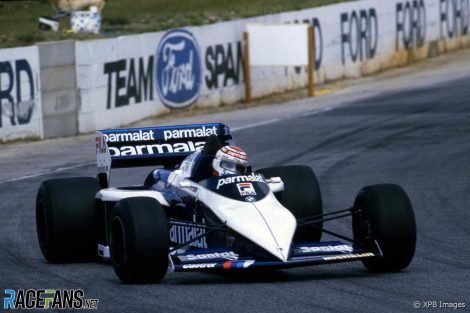
From the front row, Piquet scorched off into the lead. He was two seconds clear by the end of lap one and 10 seconds to the good nine laps later. By that stage Arnoux’s engine had already cried enough and only Prost could deny Piquet the title.
Then on lap 36, approaching half-distance, Prost stopped in the pits, his turbo blown. Piquet learned through his pit board, and realised the only remaining threat to his title was a car problem. Quickly, he turned the boost down and began coasting home.
His lead stood at 8.6 seconds over team mate Riccardo Patrese on lap 37. By lap 61 he’d backed off enough for Patrese to take the lead, and 11 laps later Niki Lauda’s McLaren relieved him of second place – though soon after he became the day’s 13th retirement.
Andrea de Cesaris took second place from Piquet on lap 74, but with Derek Warwick a lap down in fourth his position, and his title, was secure. But despite the championship win, team principal Bernie Ecclestone did not appreciate the lost one-two.
Advert | Become a RaceFans supporter and
Vengeance
Keke Rosberg, 1985 European Grand Prix, Brands Hatch
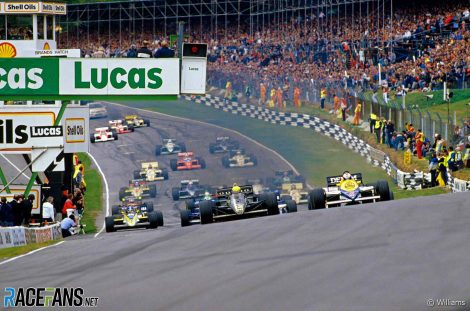
As Rosberg emerged, Senna appeared in his mirrors, the second Williams of Nigel Mansell in pursuit. Clearly rankled, the 1982 champion monopolised the inside line approach Druids, blocking Senna’s way, allowing Mansell to draw in. Once the second Williams passed the Lotus for the lead Rosberg waved his team mate by while continuing to delay Senna.
Having exacted his revenge, Rosberg put his foot down, left Senna behind and unlapped himself from Mansell. He went on to join the pair on the podium in third place, Mansell scoring his first grand prix victory thanks to his team mate’s shenanigans.
Sabotaged
Perry McCarthy, 1992 British Grand Prix qualifying, Silverstone
When Mansell put his all-conquering Williams-Renault FW14B on pole position for his home race in 1992, only his team mate got within two seconds of him. But if Mansell made everyone look slow, one driver was far further from the pace than the rest: Perry McCarthy, also in his home race, whose Andrea Moda lapped 27.7 seconds slower than the pole winner in pre-qualifying.McCarthy’s time was so far from the pace not merely because the team’s Coloni-derived chassis was hopeless – team mate Roberto Moreno lapped some 17 seconds quicker. No, the team was trying to save money by only giving Moreno a shot at qualifying, and sent McCarthy out to tackle a bone dry Silverstone on a set of wet weather tyres.
The team pulled a similar stunt two weeks later in Hungary, where McCarthy was sent from his garage 80 seconds before the chequered flag dropped, leaving him insufficient time to start a lap. At this point the FIA threatened them with a race ban if they didn’t make a sincere attempt to qualify McCarthy’s car. They did, but that race at Spa proved the last before the team folded.
Save money
Heinz-Harald Frentzen and Enrique Bernoldi, 2002 French Grand Prix, Magny-Cours
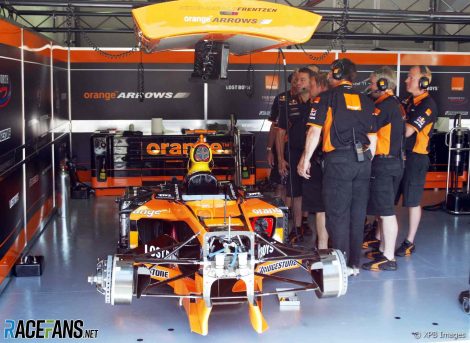
At the French round they sat out first practice, and in the second did only installation laps. Come qualifying Heinz-Harald Frentzen and Enrique Bernoldi did set times, but took care not to lap within 107% of the quickest driver, and therefore failed to gain places on the grid. Frentzen cut it remarkably close, his 1’18.497 being within one-and-a-half seconds of the mark, which was an impressive effort for his first proper lap that weekend.
The story ended the same way as Andrea Moda’s, too: The team lasted one more race before folding.
Advert | Become a RaceFans supporter and
Qualify on pole
Michael Schumacher, 2006 Monaco Grand Prix, Monte-Carlo
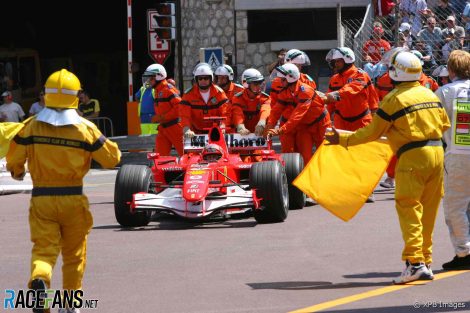
That brought out the yellow flags which made it impossible for his rivals to beat his time. But the stewards were convinced Schumacher had pulled up intentionally, noting his “undue, excessive and unusual” braking on the way into the corner, and sent him to the back of the grid.
Others have been accused of doing the same since, albeit more subtly. As a result, Formula 2 and Formula 3 are trialling new rules this year which give the stewards the power to delete the lap times of drivers who cause red flags in qualifying sessions.
Double stack
Kimi Raikkonen, 2005 Belgian Grand Prix, Spa-Francorchamps
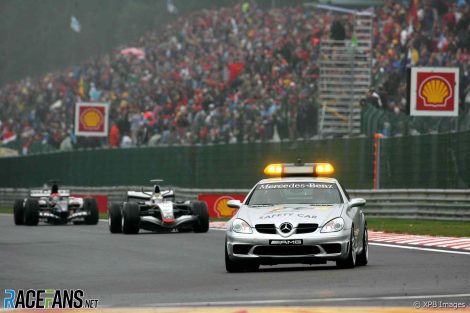
The team had prepared for the situation, however. Raikkonen backed off, knowing the cars behind him were not allowed to overtake, letting Montoya pull around half a minute ahead. That gave McLaren ample time to service his car before Raikkonen’s, ensuring he lost no places to the others who pitted.
McLaren weren’t the first team to try something like this, but the execution was so egregious it prompted the FIA to act. Drivers were warned similar tactics would lead to a penalty, and Fisichella fell foul of the rule three races later in Shanghai.
Today drivers must adhere to delta times during Safety Car periods which in theory prevent these tactics, but they invariably push it as far as possible. McLaren’s Lando Norris was penalised for it in Canada last year, and during last weekend’s race Charles Leclerc accused Sergio Perez of purposefully slowing down as he headed to the pits behind his team mate under Safety Car conditions.
Advert | Become a RaceFans supporter and
Team orders
David Coulthard, 1998 Australian Grand Prix, Melbourne
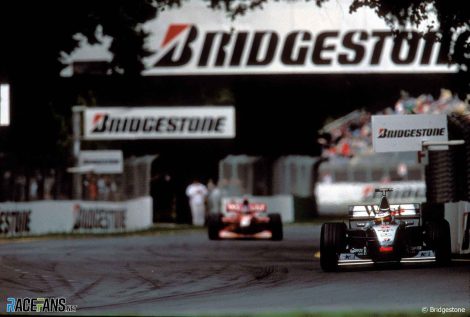
But David Coulthard had to go somewhat further than that when his race-leading team mate Mika Hakkinen made an extra pit stop in error at Melbourne in 1998. His unnecessary third visit to the pit lane left the former leader 13.3 seconds behind the other McLaren.
The team told Coulthard to let Hakkinen back past, and over a period of seven laps he let his team mate close to within a second and a half. At that point, lap 52, Coulthard let the gap stabilise. By lap 55, with three laps left, his lead was back up to 2.2 seconds.
Was he having second thoughts? If so, he dispelled them, waving Hakkinen by into the lead on the 56th tour. He stayed on his gearbox, however, the pair crossing the line separated by just seven-tenths of a second.
Paddock politics
Norberto Fontana, 1997 European Grand Prix, Jerez
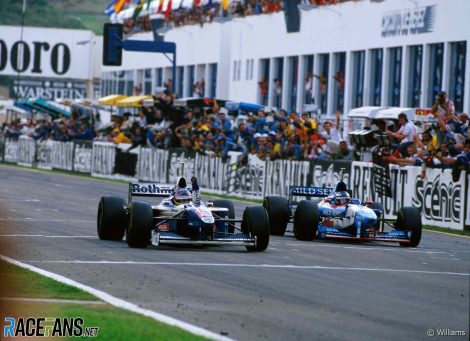
Sure enough, when Schumacher appeared behind Fontana the Sauber driver made way – then sat in front of Villeneuve for a full lap, holding him up by over two seconds. In the nip-and-tuck battle between the title contenders, it could have swung the outcome. But Villeneuve closed back on his rival, made his bid to pass him – and so there a controversy which eclipsed Fontana’s antics.
As a result of incidents such as these F1 now has some of the strictest rules on why backmarkers must obey blue flags to let drivers past.
Advert | Become a RaceFans supporter and
Ultimate team mate
Sergio Perez, 2021 Abu Dhabi Grand Prix
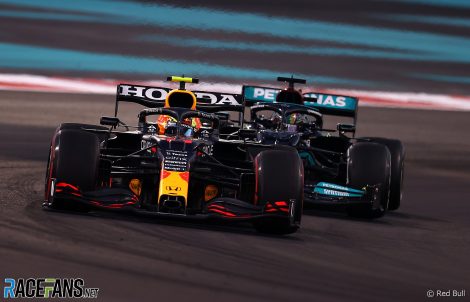
Despite Hamilton’s fresher tyres, Perez did this masterfully, frustrating the Mercedes for more than a lap of the Yas Marina circuit. Verstappen closed in behind as the tension mounted, and Hamilton’s lead over his rival falling from 8.5 seconds to just 1.1.
Finally, Hamilton slipped by, and Perez dived aside for his team mate. “Oh, Checo is a legend,” praised Verstappen.
It wasn’t enough to put Verstappen ahead – that came about due to the race director’s mishandling of a Safety Car period later in the race. However, had Perez not delayed Hamilton so effectively, the Mercedes driver could have had the opportunity to pit for fresh tyres and maintain track position over his rival during that notorious conclusion to the race. The fact he couldn’t do so proved crucial in the controversial conclusion to that championship.
Last roll of the dice
Lewis Hamilton, 2016 Abu Dhabi Grand Prix, Yas Marina
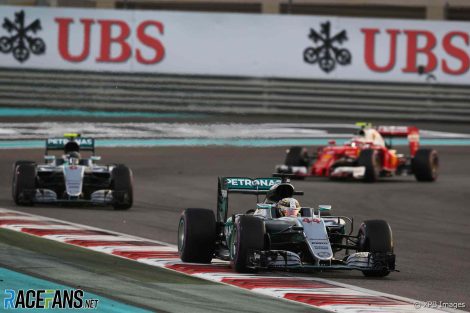
So as the Mercedes ran first and second over the final laps, Hamilton took the only remaining course of action available. To the consternation of his team, he slowed down and began backing the second Mercedes towards the chasing pack.
First Verstappen, then Sebastian Vettel took turns behind inspecting Rosberg’s rear wing. But while Hamilton turned up the pressure, he never tightened the screw to the extent he had to defend from his team mate, which might have given their pursuers the opportunity they – and he – wanted.
As the laps ran out, Hamilton won the race but Rosberg clinched the championship – and decided he’d had enough. Five days later he announced his retirement from Formula 1.
Advert | Become a RaceFans supporter and
Over to you
When else have racing drivers surprised you by slowing down in Formula 1 and other series? Share your favourite stories in the comments.
F1 history
- How you rated F1’s 12 sprint races so far – and why two outscored the grand prix
- Alonso set to become F1’s oldest driver for more than 50 years
- From ‘Flying Pig’ to Senna’s heroics: The short, incredible history of Toleman
- From farcical to fantastic: Formula 1’s 14 title-deciding Japanese races ranked
- Benched: The five other drivers who stood down for team mates in last 50 years




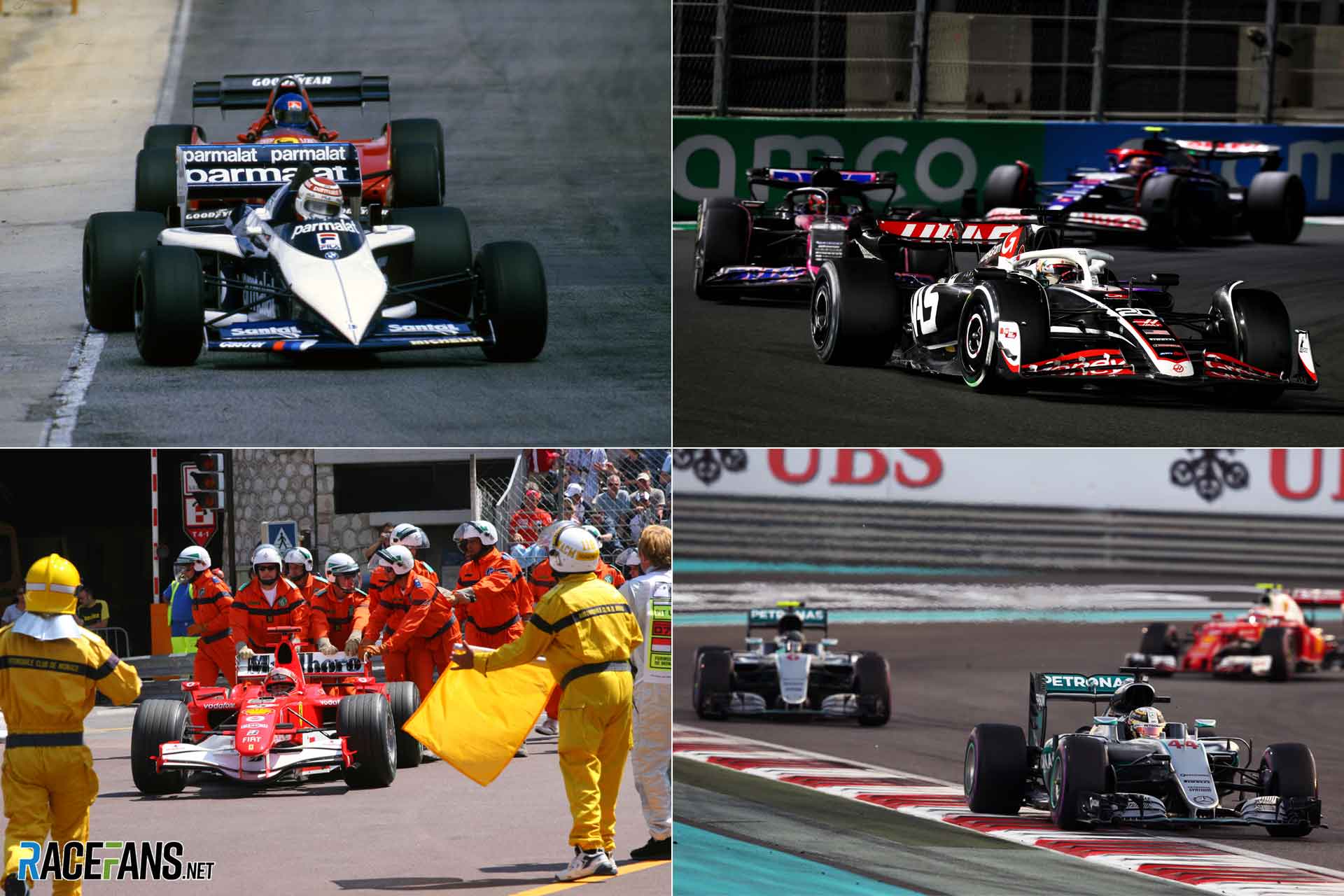
Derek Edwards
15th March 2024, 12:04
Can you throw out the anchor and still win? If so, Villeneuve, Jamara, 1981.
Mooa42
15th March 2024, 23:34
Ricciardo at Monaco in 2018
montreal95 (@montreal95)
16th March 2024, 3:07
Jarama 81 and Monaco 18 are not examples of someone going intentionally slowly.
Villeneuve drove that dog of a Red Cadillac faster than anyone thought it could ever go. Every one of the 5 cars on his tail was much faster anf yet he still won.
Riccardo lost 160hp from the failed ERS. He drove expertly to still win. Of course at every other track bar Monaco even his expert driving wouldn’t have been enough.
Danny
15th March 2024, 12:14
Perez AD 2021
Nick T.
15th March 2024, 13:11
That just Perez not letting him pass easily. Not intentionally going slow. Way different IMO and shouldn’t be on the list. BTW, I have an intense dislike for Max. So this opinion wasn’t for his benefit.
The ever classy Max then proceeded to refuse to let Checo by in Brazil (a swap of 6th and 7th), which cost RBR the 1-2 WDC they wanted. So, whatever beef he had with Checo, didn’t excuse even a tenth of it.
Alesici
15th March 2024, 13:23
Perez is not a very fast driver, but even he definitely could have gone heck of a lot faster when holding back Hamilton in that race. He was temporarily several seconds off the pace.
David BR (@david-br)
15th March 2024, 13:26
Have to disagree: Perez was trying to slow down Hamilton as much as possible without (obviously) letting him past, which would end any such attempt. Nobody would want or need to lose 4+ seconds for two laps stopping a driver from passing, that just sabotages their own race. So clearly it was for Verstappen’s benefit. And indeed it worked (along with Masi’s help).
Nick T.
15th March 2024, 13:39
I’m sure there’s a lap chart that could show how fast he was going and much his times changed before Hamilton caught up. IIRC, they left out Perez for longer than he might otherwise would have been. So, a slow down tactic teamwise at least.
David BR (@david-br)
15th March 2024, 17:24
Nick, it was blatantly clear watching the race live! Perez sped down the straights, obviously, but slowed as much as possible in the tighter corners. Hamilton could have tried forcing his way past but – let’s be honest here – he knew full well that Perez would have zero aversion to then ‘allowing’ a collision to happen. Same tactic Verstappen used at the race start, diving into the first corner knowing that Hamilton wasn’t going to risk the chance of damage when he had to beat Verstappen to win the championship.
MattDS (@mattds)
15th March 2024, 14:35
Please explain how the two points between sixth and seventh place cost Perez second place in the WDC that he lost by three points. Some advanced maths at work that I am clearly not grasping.
Nick T.
15th March 2024, 15:38
Brazil was before the last race. So, it doesn’t matter whether he would have ended up losing either way. So, unless Max could see into the future, the fact that he did what he did shows what kind of person Max is.
F1 frog (@f1frog)
15th March 2024, 12:32
The 1997 European Grand Prix was filled with dirty tactics and arguably neither deserved to win that day. It is most famous, of course, that Schumacher turned in on Villeneuve deliberately, but Fontana’s instruction from Jean Todt that ‘Villeneuve must be held up’, and the Williams-McLaren collusion, particularly Hakkinen and Coulthard basing their strategies around not hindering Villeneuve, were just as bad. Certainly an example of race fixing and I would suggest legal action to get the race annulled and Schumacher declared champion is in order.
roadrunner (@roadrunner)
15th March 2024, 12:57
I heard Villeneuve was running illegal fuel that season, so let’s hand it over to Frentzen :)
An Sionnach
15th March 2024, 13:18
Nah, give it to Massa.
José Lopes da Silva
16th March 2024, 20:06
Stop it. Frentzen stated clearly he was joking.
We’re about to create another internet freak conspiracy
Bullfrog (@bullfrog)
15th March 2024, 15:42
Heh, nothing suspicious about the qualifying results either…
roadrunner (@roadrunner)
15th March 2024, 12:38
Thanks for the nice reminders, Keith. I remember them vividly.
Here are some more rather famous examples from the late 90s:
Suzuka 1997: Villeneuve started from pole position (but was likely to be disqualified) and slowed the whole field down by 3-4 seconds a lap to gave them a run at Schumacher.
Irvine got by them both and backed Villeneuve up later in the race.
Also Jerez 1997: Frentzen sacrificed his race when he slowed down Schumacher to help his teammate catch up to Schumacher (after Fontana blocked Villeneuve)
Malaysia 1999: Schumacher backed Hakkinen up for the whole race.
Suzuka 1999: The lapped Coulthard held Schumacher up in his pursuit of Hakinnen like Fontana did to Villeneuve.
Nick T.
15th March 2024, 13:13
McLaren did it with Sainz and Norris to an egregious degree in Monaco one season. I forget which. I was astounded none of then commentators seemed to notice it during the race. It was mentioned afterward, including on RF.
An Sionnach
15th March 2024, 13:26
Alonso did a go slow at Monaco in 2022. Like the Saudi race, this makes a mockery of the track more than anything else. Monaco could be a non-points opener, or split the points to allocate some for qualifying to keep things a little interesting. This Saudi race should be dropped completely when the new track is ready.
Nick T.
15th March 2024, 13:40
That was for his own race and was really smart. He didn’t kill his tires. Let a gap open up and then charged. If the guys behind him hadn’t scrambled all over the back of him, they would’ve been in a healthy position.
Keith Campbell (@keithedin)
15th March 2024, 16:00
It wasn’t actually smart on that occasion because he overdid it – he gave Norris ahead a gap to pit into which he then used to claim fastest lap. I think Aston would have preferred the point going to Red Bull.
Frank
15th March 2024, 16:15
I was also thinking about those examples in the 90s.
And didn’t Ricciardo win at Monaco by backing up the entire field and prevent an undercut?
In any ccase, Haas is not the first team to employ a riding rode block.
Stevan Vasiljević
15th March 2024, 17:29
With Ricciardo in Monaco it was different: one of his cylinders was not firing, so he raced with only five working cylinders. Hence his laps were about 7 seconds slower then usual, but still noone could ovetake him.
frood19 (@frood19)
16th March 2024, 6:54
I seem to remember Ferrari doing it to Williams in Spa 1999 – I forget the detail apart from Patrick Head getting really angry about it and saying he hoped McLaren won the title that year.
DaveW (@dmw)
15th March 2024, 12:39
Great write up!
The details of the gaps in qualifying and races should also sober those pining for the days of yore when aero was dimly understood and Close Racing reigned. A race with pole decided by a few tenths and 10 cars on the lead lap would have been bewildering back then.
Retired (@jeff1s)
15th March 2024, 12:54
Fascinating introspection, plus I loved the last line :
Jonathan Parkin
15th March 2024, 13:03
Michael Schumacher did another go slow in Hungary 1994 which gave Jos Verstappen his only on the road podium
Martin Brundle was having car problems and he let Schumi through too quickly. After he enquired about Verstappen’s whereabouts he slowed down forcing Brundle to unlap himself.
He then allowed Verstappen to unlap too so they were both on the same lap. As a result when Martin stopped on the last lap he lost his third place
MacLeod (@macleod)
15th March 2024, 13:28
I have only 1 problem with Magnussen slow down is that he overtook Yuki outside the track and didn’t got a drive through penaulty so he had to move out the way as Yuki overtook him legaly but lost the possition because a overtake outside the track.
The other slow downs were legal …
roadrunner (@roadrunner)
15th March 2024, 13:33
Agreed with the off track pass. Also I don’t like lapped runners intentionally holding up people.
MichaelN
15th March 2024, 14:03
As so often, Schumacher did it best in Malaysia 1999.
He also held up his brother in Spain 2000, even forcing him wide to allow a chasing Barrichello to sneak past the both of them. Schumacher had a faulty set of tyres then so the slowdown wasn’t planned as such.
Irvine tried at the Nürburgring in 1998, but Häkkinen got by before Schumacher could build the necessary gap to keep the much faster McLaren behind.
Red Andy (@red-andy)
15th March 2024, 14:45
Coulthard, Spa 1998.
An Sionnach
15th March 2024, 20:41
That’s what I was thinking. Took out the whole field and then Schumacher later on!
Fer no.65 (@fer-no65)
15th March 2024, 22:44
i don’t think it was a deliberate attempt tho, it was just a brain-fart from his part.
MGus.ai
15th March 2024, 14:55
I think Lauda said once: autoracing is being the fastest on track on the slowest mode possible,
earthling (@34rthl1ng)
17th March 2024, 18:55
Don’t know if Lauda said that but Fangio said it first
Bullfrog (@bullfrog)
15th March 2024, 15:36
Carlos Reutemann at Las Vegas, 1981: what was that all about? Driver or car trouble, conspiracy or not, it was one of the strangest, lamest shots at a world championship title.
It was revisited a fair bit last year before F1’s return to Vegas, and my favourite story was the one about Piquet or Bernie Ecclestone bribing the masseur not to turn up for Reutemann’s appointment before the race…
Tom Baker
15th March 2024, 21:13
I don’t know if Lole eventually got his massage that weekend but he certainly didn’t get a happy ending.
Sumedh
15th March 2024, 16:38
I think we should also add the 2019 Monza qualifying to this. All drivers going so slow, trying to be behind each other such that only Sainz crossed the finish line in time.
Stevan Vasiljević
15th March 2024, 17:33
Why no mention of Alonso slowing down Hamilton behind him in Hungarian GP, resulting in Gasly’s only race win?
Keith Collantine (@keithcollantine)
15th March 2024, 17:59
Good thought, the way I see it Alonso had his own position to protect as well as his team mate’s and he wasn’t going particularly slowly other than the inevitable time loss due to defending.
Heiden (@heidenh)
15th March 2024, 19:22
I know this wasn’t technically F1, but it was historic.. When Joe Tanto blocked Beau Brandenburg so Jimmy Bly can extend his lead at their Canadian gran prix? :)
Stevan Vasiljević
15th March 2024, 19:32
Oh my, it was Ocon for victory, not Gasly!
Anyway, a nod to Alonso, master self promoter, for convincing me that his defence was a sacrifice for the team, and not for his own benefit.
Diego
15th March 2024, 19:43
Singapore 2019. Leading pack did so much tyre saving that Giovinazzi / Alfa Romeo had a shot at leading a GP.
Tom Baker
15th March 2024, 21:05
There have been efforts to throw out the anchor at Red Bull recently. Or did I mishear that slightly?
DieRooiGevaar
15th March 2024, 23:18
How about that time Timo Glock suddenly found a handbrake on his Toyota at the end of the last race of the season, handing Hamilton a championship?
montreal95 (@montreal95)
16th March 2024, 3:21
Ah yes! That strange handbrake alternatively called old dry tires on a wet track. He even managed to expertly make it look normal by being the fastest (or more accurately least slowest) of those with such tires. All the while this slimy President of the Massa ill wishers club was plotting to fix the race for Hamilton
Stevan Vasiljević
16th March 2024, 7:50
It wasn’t so; Timo Glock was driving as fast as his team mate in Toyota, both on dry tires on a wet track. Besides, article states the examples of drivers deliberately driving slower than drivers immediately behind them.
Craig
16th March 2024, 15:41
Toyota gambled on staying slicks, a gamble that actually paid off for them as they gained a couple positions on where they originally were but they were always going to be overtaken by cars on wets as the rain got heavier (try driving a kart on slicks in heavy rain, it’s not easy).
There was no conspiracy of any sort.
SteveR (@stever)
15th March 2024, 23:42
That Brabham BMW is a beautiful car.
Dantera87
18th March 2024, 18:32
Sounded the part also. Kinda like a superbike. I’d rather have a screaming 4 banger over the dull V6’s we get today
Diez Cilindros (@diezcilindros)
16th March 2024, 7:31
What about 2004 British Grand Prix, Qualifying 1, when rain was predicted for the end of Qualifying 2 and everybody went slow, spun, etc., just to make sure they went out early in Q2?
montreal95 (@montreal95)
16th March 2024, 19:12
(@diezcilindros) Good one! I totally forgot about it but you’re right. Though it’s unsurprising that I did forget. 2004 was a forgettable season for the most part. Not as terrible as 2002 but not far off
Roth Man (@rdotquestionmark)
16th March 2024, 11:06
Different example but honourable mention to Sainz at Singapore last year. Using the DRS train to protect himself.
Craig
16th March 2024, 15:38
I think we hold Perez’s 2021 Abu Dhabi performance on a higher pedestal then it deserve. Sure, he did what was expected of him in that situation but his defense didn’t last long, nor did it actually matter in the long run
Dantera87
18th March 2024, 18:31
It did matter actually (which makes it even more brilliant in my book). By being hold up by Perez, Lewis didn’t get a free pitstop when the SC came in. That’s why Merc was in a gamble regarding track position or ultimate pace. They chose the former and that proved to be the wrong decision.
Tom Baker
17th March 2024, 8:46
If one is looking for the ultimate example of slowing down for strategic reasons, surely there cannot be a more absolute case than Peter Collins at Monza in 1956 slowing down to a complete stop in the pits and getting out of the car?
He did it of course to hand his Ferrari to his team mate Juan Fangio, in order to allow Fangio, whose own car had broken down, to get back into the race and win the title.
Such car sharing isn’t allowed now, but it was not infrequently carried out on the instructions of the teams until the early 1960s. But in Collins’ case it was an entirely voluntary gesture on the part of the driver, who might otherwise have taken the title himself that day.
So if it’s not the ultimate example of slowing down (and I am of course being slightly light hearted on that score), it’s certainly one of the greatest examples of sportsmanship in the history of F1.
Dantera87
18th March 2024, 18:28
Funny how whenever 2021 teammate blocking tactics are brought up people only seem to remember Abu Dhabi and Perez.
Mercedes did it BEFORE, during the Dutch Grand Prix in that same year, by asking Bottas to hold Max down so Lewis could try and catch him.
Not one issue was raised by the eternal bri’ish press then. Come Abu Dhabi and the likes of Edd Straw and Scot Mitchel-Malm started crying all of a sudden.
Go figure…